Science
Frogs and Toads Together: Why do Amphibians Group Up?April 11, 2025

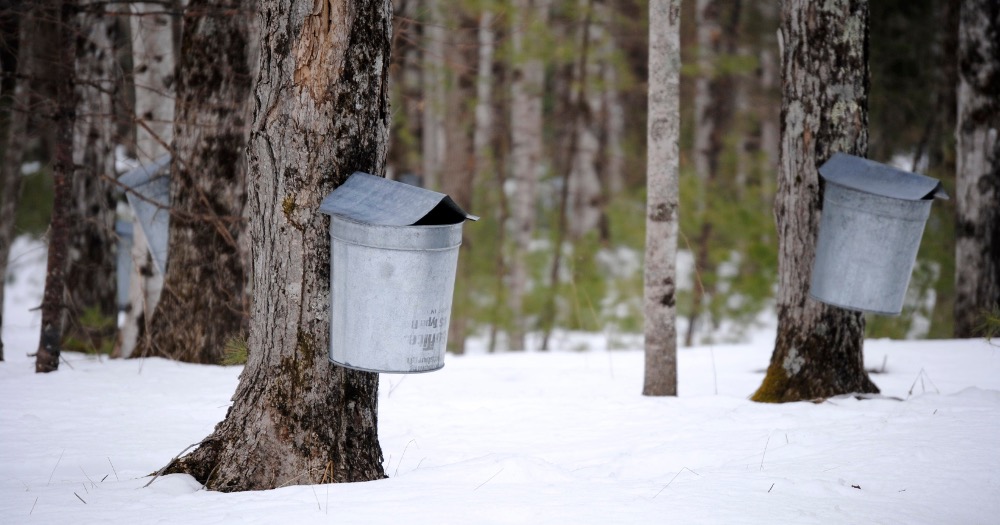
It’s almost maple syrup season again, and I can’t help but think about how magical this time of the year is for kids and adults alike. I was fortunate enough to grow up in a region that can produce maple syrup and my grandmother would take me and my three brothers to the sugarhouse at our local nature center each year. I remember walking toward the sugarhouse, seeing the steam rise out of the cupola and getting excited to take in the amazing smell of cooking maple sap. If you’ve never gotten the chance to smell maple syrup in the process, I highly suggest you find somewhere to check it out this maple syrup season, there’s really nothing like it!
I also remember all the amazing facts the interpreter would share with us. Here in mid-Michigan we have a lot of Sugar maple trees and the nature center would tap those trees to collect the sap to bring to the evaporator pan to boil down to syrup. They would remind us each year that it takes 40 gallons of Sugar maple sap to make 1 gallon of syrup! It still blows my mind! We would often get the chance to go into the sugarbush and help collect sap from the buckets and bring it back to the sugarhouse. At the end of our visit, if we were lucky, we’d get a chance to try pure maple syrup on a stick; a super sweet end to our time!
With all the magic happening in sugarbushes, how can maple syrup season help you teach your elementary students? There are many scientific principles that can be covered by this wonderful time of year and they are laid out for you toward the end of this article. Before we get into the standards and activities to work towards those standards, I’ve put together some background information about the maple syrup season for you to add to your knowledge base for a better overall understanding of how sugaring can help you with your curricular goals.
Affiliate disclosure: As an Amazon Associate, I may earn commissions from qualifying purchases from Amazon.com. This is at no extra cost to you. If you’d like to learn more, check out my disclaimers page.
Don’t need all of the info? Use this list to jump to the stuff you need:
Sugar maple sap to syrup ratio
Maple syrup book: Maple Syrup from the Sugarhouse
Asking the question “when is maple syrup season?” does not yield a straight-forward answer. The simple answer is that maple syrup season happens when winter transitions to spring. To be able to produce maple syrup, a region needs to have two main components. First, they need to have the right species of trees that go through dormancy in winter. Second, they need to have the correct weather patterns that help move the stored sap from the roots of the trees to the branches of the trees in spring.
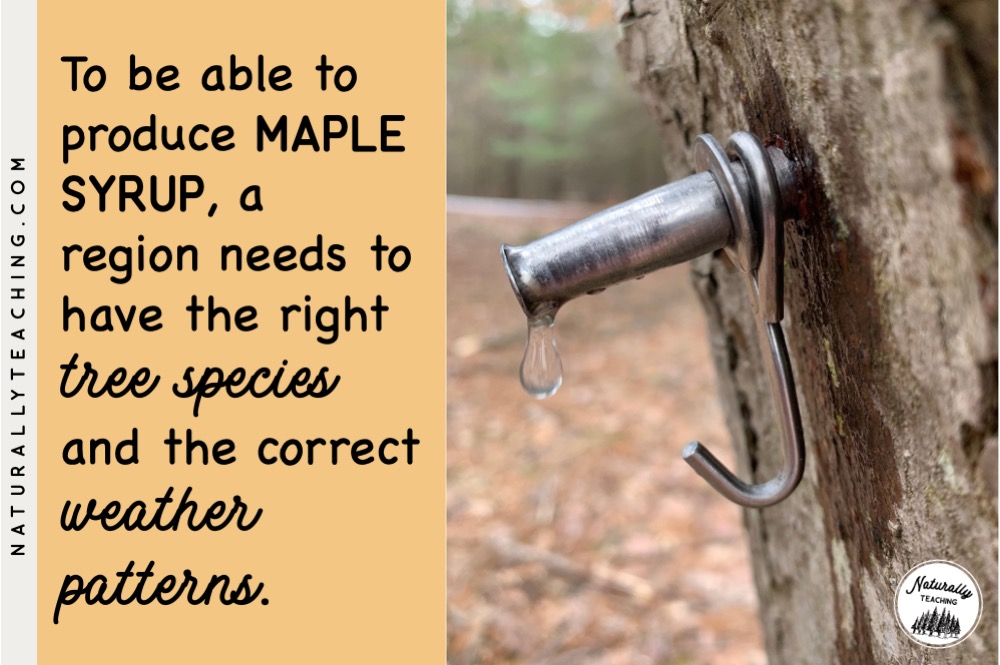
When an early spring hits the southern regions that can produce maple syrup (e.g. parts of Kentucky, West Virginia, and Missouri) they can start gathering sap as early as mid-February. During long winters, the northern regions that can produce maple syrup (e.g. Quebec, Ontario, and Maine) may not begin production until April. It all depends on the maple syrup weather.
Maple syrup weather happens in the spring and is the only time that the maple syrup season can happen. Sometimes maple syrup weather will stick around for a month while other times it can start and stop and then start again. The weather pattern that signifies maple syrup weather is above freezing, or 32℉/0℃, during the day and below freezing at night.
This special weather pattern creates a pressure build in the inner parts of the trees that pushes the sap from the roots to the branches of the tree. How does the sap get into the roots in the first place? Triggered by the fewer hours of daylight in the fall, the trees move the extra food they made during the summer down to the roots and store it as starch for the winter. When the weather shifts from winter to spring, the trees come out of their dormancy, or rest, and change the stored starch back into sugar. The sugar then travels up to the branches and opens up the buds that will be the leaves that make them new food during the spring.
If a region does not have cold enough temperatures for the deciduous trees to go into a dormant state in the fall, they cannot produce maple syrup. Regions that have deciduous trees that go dormant in the fall and experience extended periods of above freezing during the day and below freezing at night can produce maple syrup.
So, which areas have both the correct trees and weather patterns to produce maple syrup? Most of the world’s supply of maple syrup comes from Canada and the United States which makes it a very coveted (and expensive) breakfast sauce! Other countries that have produced maple syrup on a small scale include Japan and South Korea, but the majority of the market remains with Canada and the U.S.
Canada is the largest producing country in the world for maple syrup, contributing about 80% of the world’s supply. The largest producing provinces are Quebec, New Brunswick, Ontario, and Nova Scotia. However, Manitoba and Saskatchewan have begun producing maple syrup from the sap of Box Elder and Manitoba maple; a more laborious process since their sap does not have the same sugar content as sugar maples. British Columbia is also starting to produce maple syrup, however, they are using the sap from the Bigleaf maple.
The United States is the second largest producing country of maple syrup. Vermont is the largest producing state, followed by New York and Maine. Some other states that produce marketable quantities of maple syrup include Michigan, Ohio, Wisconsin, New Hampshire, Massachusetts, and Connecticut. Other states that have the ability to produce maple syrup but don’t make it a huge industry include Minnesota, Iowa, Missouri, Kentucky, West Virginia, Virginia, Pennsylvania, Rhode Island, and New Jersey.
All species of maple trees can be used to make maple syrup. There are preferred species based on the sugar content of the sap. The higher the sugar content, the less boiling required to turn sap into syrup. The Sugar maple is the famous tree for producing maple syrup since its sugar content is approximately 2-5%. The Black maple also has around 2-5% sugar content in its sap, but has a smaller range of where it can grow. The Red maple has anywhere from 2-4.5% sugar content. Some other species that have high sugar content would be Amur maple (2-4%), Silver maple (2-3.5%), and Box Elder (1.5-2.5%).
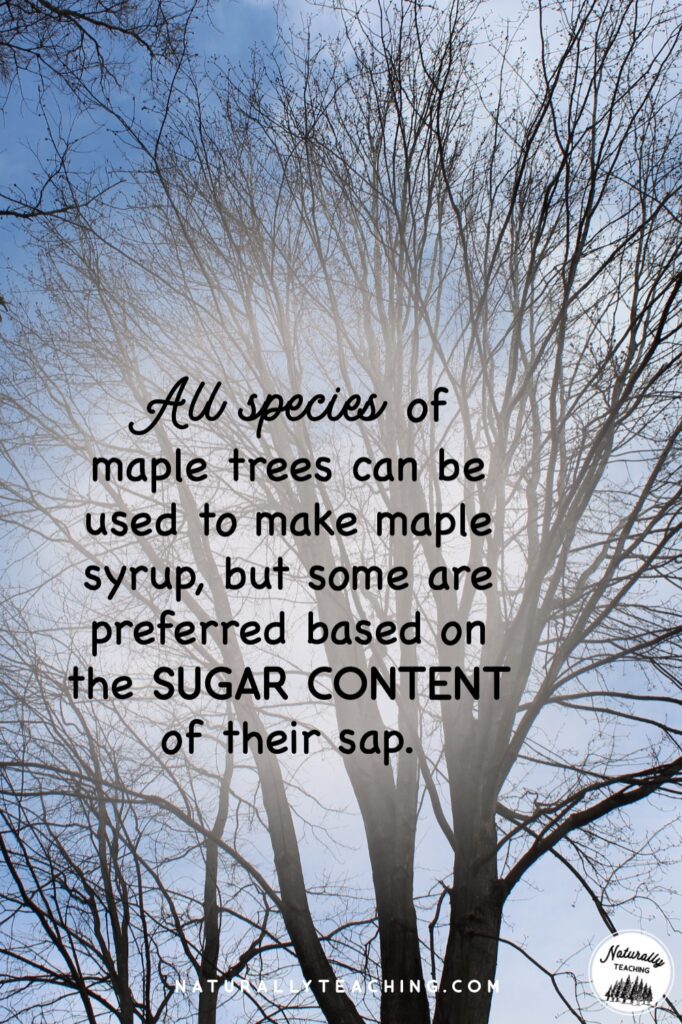
To get this sugary sap out of the tree, a tap must be placed into the inner bark of the tree. Nowadays, many people use cordless drills, a hammer, stainless steel spiles, and collection containers (e.g. plastic buckets, milk jugs, coffee cans, stainless steel buckets, sugaring bags, etc.). After the weather has shown to be the appropriate maple syrup weather, it is time to go out and tap trees.
To tap a tree, drill a hole in the tree about 2-4 feet above the ground. When drilling, make sure that the hole isn’t parallel with the ground or drilled at a downward angle; you want gravity to help you collect sap, so make sure there is a slight upward angle to the drill bit when you make your hole. Only drill in about 3 inches so that you get into the inner bark of the tree but not too far. Gently tap in the spile with the hammer. If you tap the spile in too far it will be difficult to get out at the end of the season; be careful to take care of your tree so you can use it again for years to come. To keep your tree healthy, make sure to only put in an appropriate number of taps so that you are not over harvesting the sap the tree needs to open its buds in the spring. If you have a tree that is less than 10 inches in diameter, do not tap it. If it is 10-14 inches, you can place 1 tap. If it is 15-19 inches in diameter, you can place 2 taps. If you’re doing this for fun or as a study with your students, you can make it a habit to only place 2 taps in your largest trees to help them stay healthy and to keep your labor down.
Although maples are the preferred tree to produce syrup with, other species of trees have been known to produce some sweet syrup. These trees have lower sugar content in their sap so the boiling time is longer, but the same process could work to produce syrup. Birch trees tend to have less than 1% sugar content, taking 110 gallons of sap to make 1 gallon of syrup. Alder trees are related to birch trees and have a similar sugar content. Nut trees, such as Black Walnut and Butternut, begin sap movement around the same time as maple trees but for a longer stretch of days, essentially elongating the sugaring season. Sycamore trees, Linden trees, Ironwood trees, Hickory trees, and Elm trees are other species that have been reported to make delicious syrups, all with their own unique flavor profile.
Sugar maples tend to have anywhere from 2-5% sugar content in their sap. That means that there is 95-98% of the sap that is water and the rest is dissolved sugar. To get the sap to syrup, the water must be boiled out so that there is 33% water left and 67% sugar. When the sap is boiled, the water evaporates but the sugar remains in the pan. This is how the ratio changes from mostly water to mostly sugar.
To simplify it, it takes about 40 gallons of sugar maple sap to produce 1 gallon of maple syrup. The sugar maple sap to syrup ratio would be 40:1.
How maple syrup is collected varies based on the intention of the production as well as the supplies of the collector. Starting with an in-home or at-school production, some people will use sugaring bags or plastic gallon containers that hook to the spiles to collect the sap. After they have filled with sap, people have to walk around to the different bags and containers and dump them into a large collecting container to be taken for boiling.
Moving up the scale in size, small to midsize sugarbushes may use stainless steel buckets hanging on their trees. Similar to the in-home production, the buckets need to be emptied into a collection container to be taken for boiling. These productions tend to put more money into the process and may use a large collection tank on a trailer that can be driven around to make the collection process quicker and less laborious.
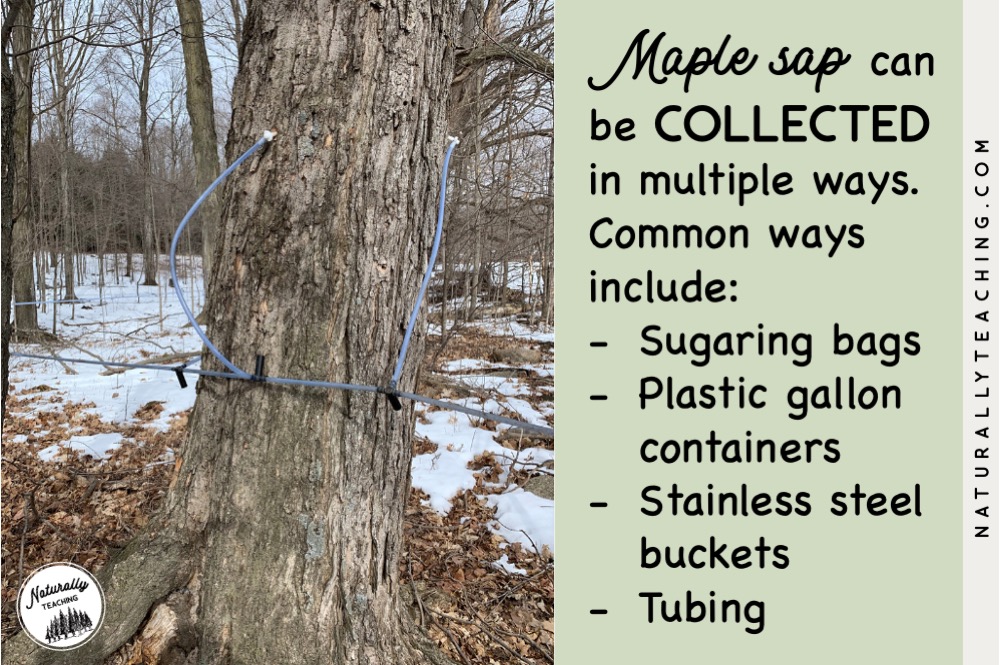
Large commercial sugarbushes may use stainless steel buckets, but more likely will connect their trees with tubing that is connected to a pump. This technique allows the staff at the sugarbush to have a constant flow of sap coming into their boiling set-up thanks to the pump in the forest. This helps to speed up production as well as take advantage of the entire maple syrup season. The sugarhouse is often downhill from the tubing and pump to use gravity to help the process be more sustainable.
Because maple sap is made mostly of water, the sap itself will begin to boil at the boiling point of water, 212℉ or 100℃. To get the sap to turn into maple syrup, the boiling must continue for hours to evaporate the mass amounts of water out of the solution. When the syrup has reached the 33% water and 67% sugar content it is syrup. The temperature maple syrup boils at is 219℉, or 104℃.
When considering how to boil maple syrup, many in-home or at-school productions will put together an outdoor turkey fryer powered by propane in a batch method. This means that the sap will stay in one pan the entire time that it is being processed. This will require a watchful eye as the water evaporates out and the solution gets closer to the syrup ratio of water to sugar.
Midsize commercial sugarbushes often process their sap with an open pan evaporation with dividers over a fire. Sap is added to the pan and the evaporation process begins. The dividers help to separate the sap at different concentration levels. As the sap gets boiled down, fresh sap needs to be added to the pan to keep everything moving and to keep burning from happening. The fresh sap will remain in one divider and the more sugar-dense sap remains in the other dividers. When the divider closest to the draw off valve is syrup, the evaporator can open the valve and release the finished product without pulling out unfinished syrup. More sap is added to the first divider, moving the more dense sap into the other dividers, and the process continues.
Large commercial sugarbushes are moving to a more fuel efficient process using reverse osmosis. These large machines use a procedure that is often used to purify water by extracting sugar, minerals, and other impurities from the source. Instead of keeping the purified water that is a byproduct of the process, the sugarbush keeps the concentrated sugar solution as maple syrup. This process uses less fuel and decreases the boiling time required to produce syrup by as much as 60-75%.
If you’re looking for a maple syrup book to introduce the maple syrup season to your students, consider Maple Syrup from the Sugarhouse by Laurie Lazzaro Knowlton. The story begins with the main character, Kelsey, recognizing the maple syrup weather as winter transitions to spring. Her and her father head out with buckets and spiles to put taps in the maple trees. They invite family and friends to help them collect the sap from the buckets to take to the sugarhouse to boil. In the sugarhouse, the author does a nice job explaining the evaporating pan, how gravity helps the process, where the fire is, and how the evaporation takes place. Description is given for how the father tests the syrup to see if it has the right sugar content and what he does when it’s time to draw off the finished syrup. After all the hard work is completed, a celebration takes place with pancakes, sausage, biscuits and coffee. This book has lovely pictures by Kathryn Mitter that illustrate the different steps to the maple syrup season, helping your students visualize this unique process.
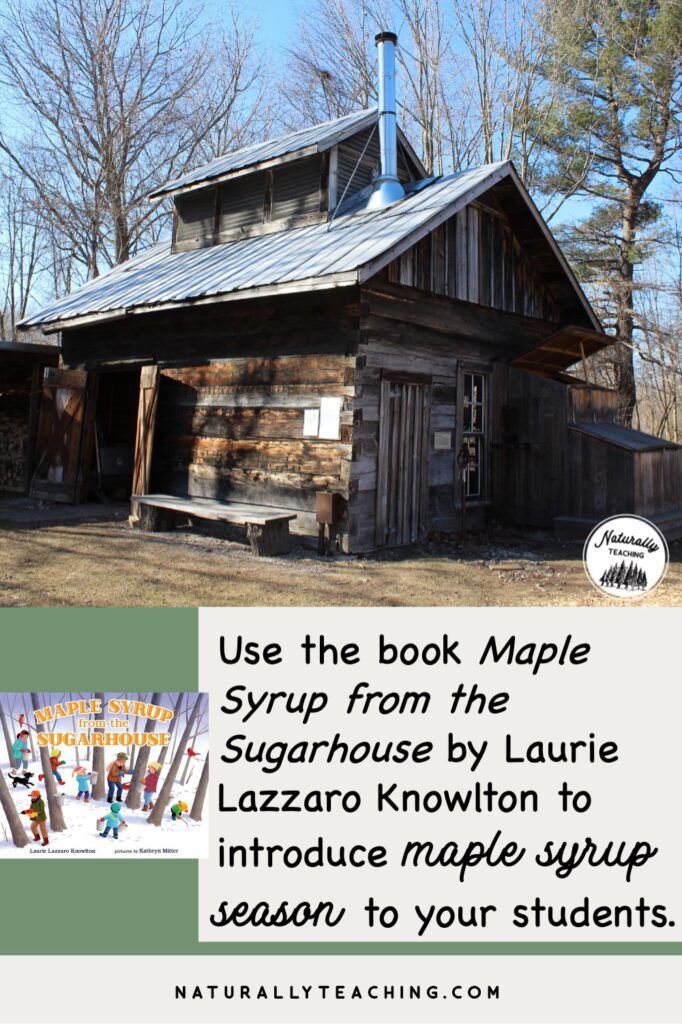
Maple Syrup from the Sugarhouse is full of incredible scientific principles that your students of all grades can enjoy. Read on to find an activity you can do to embrace the maple syrup season in your classroom while also fulfilling your science standards. These activities are guided by the Next Generation Science Standards but could be altered to fit your students’ needs and age.
In the Next Generation Science Standards, kindergarteners get the opportunity to learn about weather. The standard K-ESS2-1 states that kindergarteners should: “use and share observations of local weather conditions to describe patterns over time.” Maple syrup season is a great way to study local weather and the changes in the seasons.
Read the story Maple Syrup from the Sugarhouse to your kindergarteners. Have them listen closely for the changes in the weather that are mentioned at the beginning of the book. What clues does Kelsey notice that the weather is changing? Kelsey notes that she feels the sun, sees the snow melt, and the ground thaw. Her father also mentions that the nights are freezing and the days are warmer. There is a lot of weather stuff happening in just those two pages! Finish reading the book and talk about the maple syrup weather that you, the teacher, learned about earlier in this article.
Take some time to work with your students to create a maple syrup weather scavenger hunt to take outside. Weather elements that you could put on this scavenger hunt include:
After your class has brainstormed a list of things that would show them that maple syrup weather has arrived, go outside with your scavenger hunts, clipboards, and pencils to look for the weather elements on your scavenger hunts. When you get outside, have your students line up on the sidewalk and share with them their exploration space using natural boundaries that are easy to see (fence line, playground, sidewalk, tree line, etc.) and how you plan to call them back when their exploration time is up.
Allow your students a fixed amount of time to run around and look for signs of weather, saving at least 5-10 minutes for a wrap-up discussion. While they are exploring and looking for maple syrup weather, walk around and share in their excitement and ask them questions. After their exploration time has finished, call them back with your attention getter, and have a discussion about what they found. Since they will be so excited to share, have them share with a partner and then open it up to the entire class. Do they think that maple syrup weather has arrived? Why do they think that?
If you’re feeling unsure about your weather teaching skills, check out the article “Answers to 7 FAQs to Help With Your Weather Teaching in Elementary School”.
In the Next Generation Science Standards, 1st graders get to learn about daylight and how it changes over the course of the year. The standard 1-ESS1-2 states that 1st graders should: “make observations at different times of year to relate the amount of daylight to the time of year.” Maple syrup season is a great way to connect how the changing sun is observed by people, plants, and animals.
Read the story Maple Syrup from the Sugarhouse to your 1st graders. While you’re reading, have your students keep an eye on the sky in the illustrations. As the story unfolds, the sun rises and sets to give an idea of how much time is spent evaporating the sap to make syrup. This can be a nice introduction to a discussion about hours of daylight throughout the year. Remind them that until recently, it was darker for more of the day than it was light. Now things are starting to change. How can they tell?
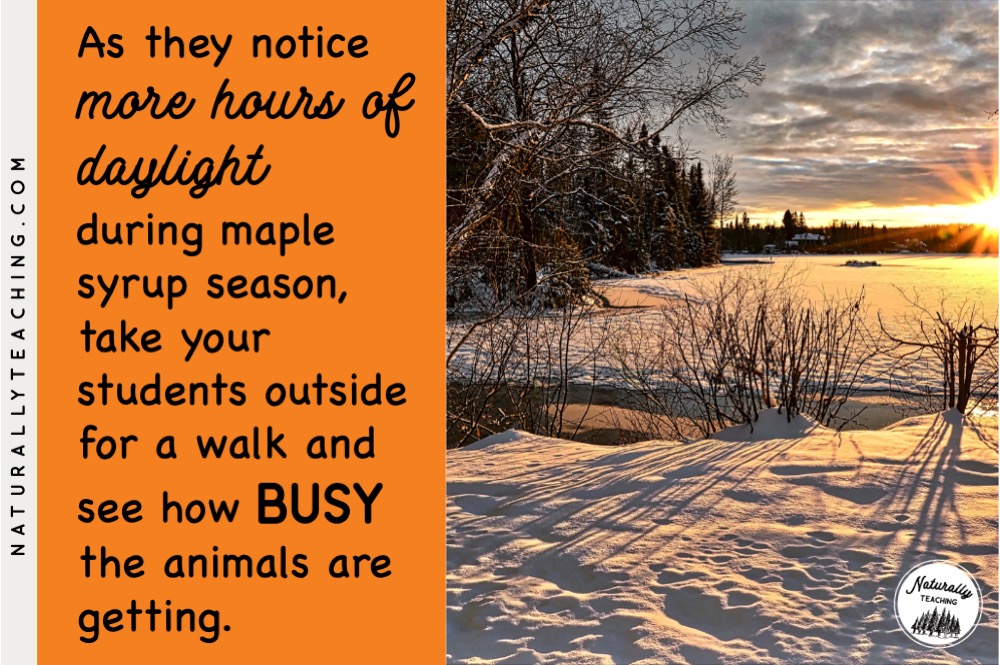
Work together to keep track of the sunrise and sunset each day. You can gather this information through an app on your phone or from the internet. Put together an anchor chart that will help you post the times each day and decide if the sun is rising earlier or later and same thing for setting. What does this tell us? As spring comes closer, there will be more hours of daylight.
As they notice more hours of daylight, take your students outside for a walk and see how busy the animals are getting. More hours of daylight signal to animals that spring is getting closer and they can start to get ready to have families. The additional hours of sunlight also signal to the plants that they should come out of their winter dormancy and get ready for spring. As spring draws closer the rays from the sun are more intense as well and the change in weather is what sparks the beginning of the maple syrup season. Continue gathering sunrise and sunset data on the same chart until the spring equinox and then start a new chart so that you can compare data when the seasons change.
If you’re wondering more about how the seasons are made and how the sun affects the seasons, check out the article “A Helpful Introduction for Teachers Teaching the Four Seasons in School.”
In the Next Generation Science Standards, 2nd graders get the opportunity to learn about water and the states that it exists on Earth. The standard 2-ESS2-3 states that 2nd graders should: “obtain information to identify where water is found on Earth and that it can be solid or liquid.” Maple syrup season is a great way to observe water in all three states.
Read the story Maple Syrup from the Sugarhouse to your 2nd graders. While reading, have the students raise their hand or put a finger on their nose if they see water in the illustrations. Pause after reading each page spread and let anyone volunteering information share their observations. After reading the book, make a list of what the students found. Have them help you sort the water into “solid”, “liquid”, and “gas” examples.
If you’re up for the challenge, you can take your 2nd graders outside to tap trees to collect sap. When they head outside, have them look for water in the different states around your school and playground. There will likely be snow on the ground or puddles along the sidewalk. Ask your students if they think the water they are seeing is in the solid, liquid, or gas state. When you tap the tree watch for drips of sap. It looks like water because the sap is about 97% water and only about 3% sugar. Would this be an example of solid, liquid, or gas?
As you collect sap to process into maple syrup, have your students check the buckets or bags that you hung up; did they find ice floating in the sap? Is that solid, liquid, or gas? When you get to the point that you’re ready to boil the sap, use a camp stove or a turkey fryer powered by propane (with the permission of your administrator of course), to cook the sap outside. Talk about the sap; is that solid, liquid, or gas water? Talk about the steam that boils up and out over top of the pan; is that solid, liquid, or gas water?
If you are not able to collect and cook your own sap, consider finding a local nature center that processes maple sap and visit their sugarhouse as a field trip. If that isn’t feasible either, there are lots of videos you can look up on YouTube to show your students.
Loving the idea of using maple syrup to teach the role of the water cycle and states of matter to your 2nd graders but don’t feel like you have the time to plan more in your schedule? Check out the Maple Syrup and Water Cycle Mini Unit for 2nd Graders with ELA, math, and science activities to explore how the water cycle, states of matter, and reversible and irreversible processes caused by heating and cooling are intertwined with the maple sugaring process.
In the Next Generation Science Standards, 3rd graders get the opportunity to learn about climates in different regions of the world. The standard 3-ESS2-2 states that 3rd graders should: “obtain and combine information to describe climates in different regions of the world”. Maple syrup season can help you discover how climate can have a direct effect on plants and animals.
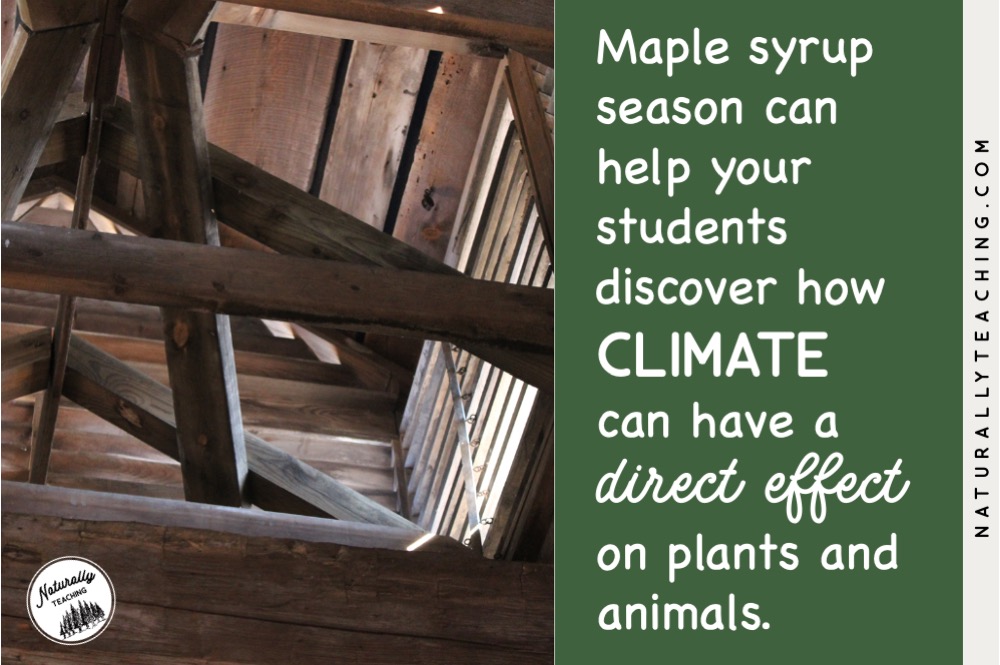
In the story, Maple Syrup from the Sugarhouse, the author begins with a brief description of the dormancy that maple trees experience in winter where maple sugaring takes place. The main character, Kelsey, describes the change in weather that hints that maple syrup season is on its way. Maple sugaring takes a very specific weather pattern and climate to be able to take place. Read the story to your students and ask them where they think maple syrup could be made.
With their responses to that question, there are a few different ways you could go about investigating their guesses. You could work together as a class to look at the climate and the weather patterns of each location. Another option would be to have them do research and write a report that they share with the class about their findings. Or, you could put together a thinking map that compares characteristics of the location in the book to the locations your students are researching; after filling out the thinking map they can determine if they think maple syrup would be able to be produced in the location they researched based on the matching or non-matching characteristics.
Whatever activity you decide to go with, your students should come out of it with knowledge about the characteristics that make up the climate in the region that they are researching. The climate and weather patterns of the regions that can produce maple syrup require maple trees to go into dormancy in the fall and then come out of dormancy in the spring when the season transitions. Having the correct kinds of trees and the correct weather patterns/climate are what make a region a place that maple syrup can be made.
In the Next Generation Science Standards, 4th graders get the opportunity to learn about internal and external structures that help plants survive. The standard 4-LS1-1 states that 4th graders should: “construct an argument that plants and animals have internal and external structures that function to support survival, growth, behavior, and reproduction.” Maple syrup season can help your students see how parts of the maple tree help it survive the harsh winter months by moving and storing leftover sugar from the summer production.
Children learn the basics of plant parts in 1st grade, but taking a closer look at the tree and all of its incredible parts can help your students see just how amazing and complex plants really are. Read Maple Syrup from the Sugarhouse to your 4th graders. Kelsey asks her father where last year’s hole is and her father tells her that the hole healed over like the scrape on her knee. Stop there and talk about that with your students. Did they know that plants can heal their own wounds? How do they think this is possible? Finish reading the story and talk about all the different parts of the tree that were involved in the maple sugaring process.
The book mentions that the stored sugar is moving and can be collected during the maple syrup season, but what is it and why is it moving? Work together with your students to peel back the layers on a maple tree and solve the mystery of the moving sap. Make an anchor chart with a diagram of a maple tree, labeling the parts of the tree that the children know. As you do some more reading and research, add more detail to the anchor chart including new structures and their jobs.
Some questions to ask your class as you work through the mystery of the moving sap would be:
These questions will get them thinking and digging deep into the anatomy of the tree. By solving the mystery of the moving sap, your students will have an amazing memory to recall how the internal and external structures of the maple tree help it survive, grow, and reproduce.
In the Next Generation Science Standards, 5th graders get the opportunity to learn about the food chain and food webs. The standard 5-LS2-1 states that 5th graders should: “develop a model to describe the movement of matter among plants, animals, decomposers, and the environment.” Maple syrup season can help your students take a look at how the energy in the maple trees can be passed to humans and animals during the transition from winter to spring.
Read the story Maple Syrup from the Sugarhouse to your 5th graders. The father in the story tells Kelsey that the maple trees grew sugar last summer and then stored it during the winter. Maple syrup season is when the stored sugar is ready to be collected. If you’ve already covered photosynthesis, you can remind your students that plants make sugar from carbon dioxide and water with help from the energy of the sun and chlorophyll. If you haven’t covered photosynthesis, now may be a good time to dive right in.
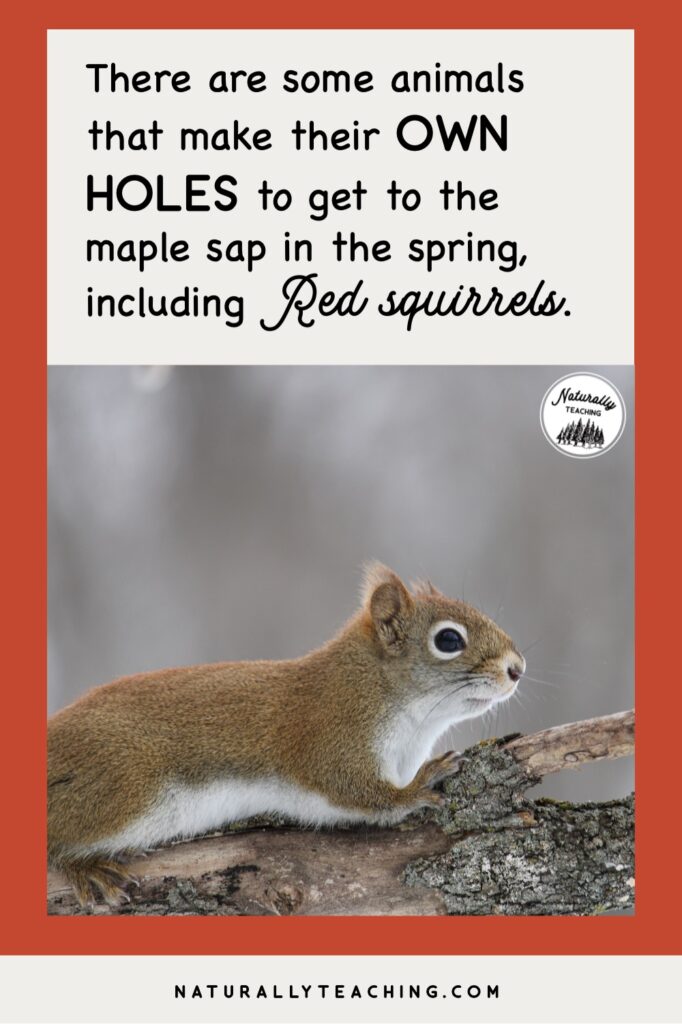
If you’re ready to take on sugaring with students, get your 5th graders out into your schoolyard or green space to tap trees. What they are doing is interrupting the flow of the stored sugar as it moves from the roots to the branches. The colorless sap contains water, sugar, and minerals and the tree’s buds will open when the sap reaches them. This will allow the new leaves to uncover and begin making more sugar for the tree to survive spring, summer, and fall.
After tapping the trees, have your students take notes on what they find in the buckets with the sap or on the tree near the tap holes. There are many animals that use the energy from maple sap in the spring. Sometimes, you can find stoneflies and other invertebrates in the sap; this is evidence that maple sap is part of the food web. There are some animals that will make their own holes to get to the sap in the spring including Red squirrels and Yellow-bellied Sapsuckers. The Yellow-bellied Sapsucker, however, doesn’t drink the sap, instead it creates holes in the tree where sap can leak out and attract insects that it will come back and eat.
Challenge your students to create a comic strip of a maple syrup season food chain. You could have them draw inspiration from the observations they made while collecting sap or they could conduct research to inspire their comic. After putting in all this hard work, you could give your students the chance to participate in a maple syrup season food chain by providing them a pancake snack with maple syrup for dipping!
Bring the magic of the maple syrup season into your classroom this spring and give your students a memorable way to connect with your curriculum. Enjoy a book, a video, a field trip, or sugaring yourself as you introduce this amazing natural phenomenon in your classroom. Whether you can maple sugar in your classroom or not, take advantage of this special time of year, it is sure to stick in your students’ memories!
If you love the suggestions in the activities for 2nd grade section, but don’t feel like you have the time to develop materials on your own, check out the Maple Syrup and Water Cycle Mini Unit for 2nd Grade with pre-made worksheets, lesson plans, background information, and an answer key.
Bibliography
Ashley. (2018, January 10). 27 Trees to Tap for Syrup. Retrieved from https://practicalselfreliance.com/trees-species-tap-syrup/
Smoky Lake Maple Products, LLC. (2019, May 29). Reverse Osmosis (RO) System. Retrieved from https://www.smokylakemaple.com/knowledge-base/what-can-a-reverse-osmosis-ro-system-do-for-me/.
Wikipedia. (n.d.). Maple Syrup. Retrieved from https://en.wikipedia.org/wiki/Maple_syrup.
Affiliate Disclosure
I only endorse things that I’ve personally used, come highly recommended by trusted peers, or I’ve done extensive research on. As an Amazon Associate, I may earn commissions from qualifying purchases from Amazon.com. This is at no extra cost to you, the commission is covered by the company.
I am recommending products that I think will be genuinely helpful and useful, and not because of the small commissions that I receive. Please only purchase items if you believe that they will help you achieve your educational goals. If you’d like to learn more, check out my disclaimers page.
Do you have any amazing experiences using the maple syrup season to teach your students? Describe them in the comments section to inspire a fellow elementary teacher to take action!
3 thoughts on “How Maple Syrup Season Can Help You Teach Elementary Students”